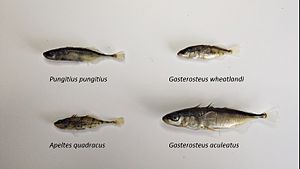Black-spotted stickleback
| Black-spotted stickleback | ||||||||||||
|---|---|---|---|---|---|---|---|---|---|---|---|---|

Black-spotted stickleback (top right) |
||||||||||||
| Systematics | ||||||||||||
|
||||||||||||
| Scientific name | ||||||||||||
| Gasterosteus wheatlandi | ||||||||||||
| Putnam , 1866 |
The black-spotted stickleback ( Gasterosteus wheatlandi ) is a species of stickleback . In the genus Gasterosteus, which is characterized by an enormous number of different populations , the black-spotted stickleback is the only stickleback with three dorsal spines that has also been granted species rank , in addition to the well - known three-spined stickleback ( G. aculeatus ).
distribution and habitat
The species prefers shallow coastal waters, so lives mainly marine. During spawning season, the black-spotted stickleback moves into the brackish water of river mouths and underflows. It also shares this habitat with local occurrences of its relatives, the four- and three-spined sticklebacks . Populations are only found on the east coast of North America from northern Newfoundland south to Long Island .
features
The black-spotted stickleback can reach a total length of 76 millimeters, but in many cases it remains significantly smaller. Its outward appearance is very similar to that of its cousin, the three-spined stickleback. In addition to differences in bone structure and in the number of gill fangs , it is mainly distinguished from it by the ventral spines . These each have two small side spines at their base. In addition, the hard ray is followed by two soft rays, with the three-spined stickleback there is usually only one. The breeding plumage also shows differences; at spawning time, the rear flanks of the male black-spotted stickleback are decorated with a black pattern that gives the species its name. The body then has a lemon-yellow to greenish gold-yellow basic color and the ventral spines are orange in color.
Number of fin rays :
- Dorsal 1 III (IV)
- Dorsal 2 5–12
- Anal I / 5-9
- Caudal 12
- Pectoral 10
- Ventral I / 2
behavior
Basically very similar in behavior to the three-spined stickleback, but it differs from it in details of the courtship behavior. The "zigzag dance" is also performed, but the male leads the female to the nest in a different posture (head down with the tail stem bent downwards). In addition, it often does not swim directly to the nest like the three-spined stickleback, but takes detours. So if males and females of the black-spotted and three-spined stickleback meet at spawning time, they try to take up the courtship ritual, but cannot "understand" certain courtship elements of the other and the courtship is broken off. This prevents crossbreeding between the two species. The average clutch size varies between 126 and 186 eggs, depending on the population. The black-spotted stickleback reproduces after its first and only hibernation, its life expectancy is around 1.5 years.
Special
In view of the great similarity between the black-spotted stickleback and the three-spined stickleback and the fact that both species share the same habitat, it is still unclear how the black-spotted stickleback was able to achieve its independence as a species.
literature
- Hans-Joachim Paepke: The sticklebacks: Gasterosteidae , Westarp Sciences, Magdeburg 1996, ISBN 3-89432-492-9
Web links
Black-spotted stickleback on Fishbase.org (English)